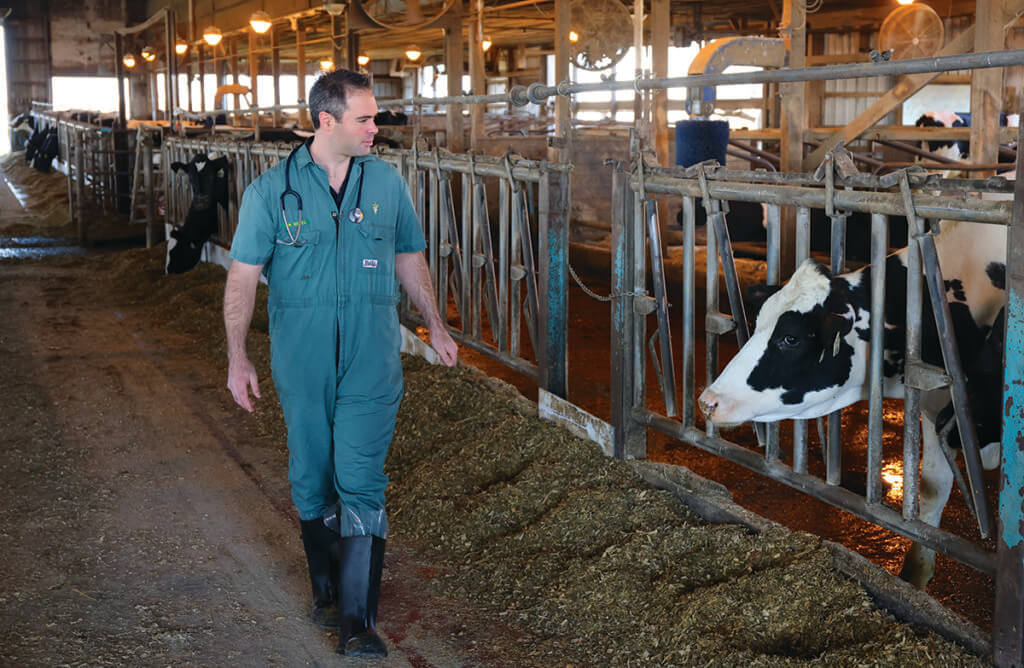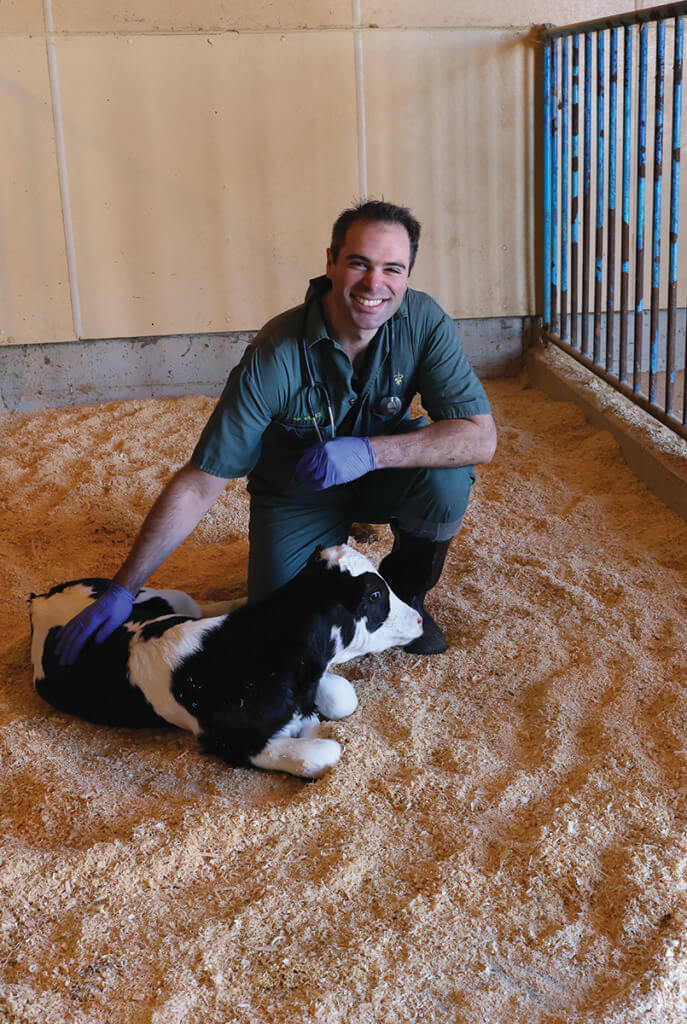
Indiana is home to more than 800 dairy farms, generating an average of nearly $700 million in direct farm income annually, according to the Indiana State Department of Agriculture. The average dairy cow produces around 2,320 gallons of milk per year, but metabolic disorders can affect that output as well as animal well-being.
Dr. Rafael Neves, Purdue Veterinary Medicine assistant professor of food animal production medicine in the Department of Veterinary Clinical Sciences, studies the link between subclinical hypocalcemia and hyperketonemia with systemic inflammation in cows. As an epidemiologist, he performs population-based studies to better understand risk factors and mitigation strategies to decrease the impact of metabolic diseases on the health and performance of dairy cows.
“Parturition is an inflammatory process,” said Dr. Neves, who also serves as section head for the Purdue University Farm Animal Hospital’s Bovine Field Service. “There is a normal degree of systemic inflammation observed after a cow gives birth, but when there is excess inflammation or the inflammation does not resolve quickly enough, those cows are at a greater risk to suffer from diseases and production losses. Concomitantly, calcium and energy requirements increase to support colostrum and milk production, and cows that fail to quickly adapt to those changes are also in limbo.”
Treatment of subclinical metabolic disorders remains difficult because a blood test is the only way to confirm a cow is affected and it’s not known why some cows develop a condition while others do not. Subclinical hypocalcemia and hyperketonemia (subclinical ketosis) are two major metabolic disorders afflicting high-producing dairy cows. Commonly associated with disorders like metritis (the infection and inflammation of the uterus), displacement of the abomasum — one part of the cow’s stomach — and lower milk production, these metabolic diseases may affect up to 50 percent of cows, according to Dr. Neves.
“Lower performing cows will be culled from the herd,” Dr. Neves said. “It’s a big problem for the industry. My lab has characterized that a great proportion of cows suffering from metabolic disorders also suffer from systemic inflammation. We want to figure out how inflammation can predispose cows to metabolic disorders.”
To conduct his research, Dr. Neves works with specific populations in commercial dairy herds to conduct large observational studies. The collected data and blood samples are then analyzed in the lab where researchers attempt to understand how an animal responds to a specific stressor.
Prevention and treatment of metabolic disorders that occur during a cow’s transition period — approximately three weeks pre- until three weeks post-calving — are essential to maintaining the animal’s health and well-being. The average dairy cow is sold after three lactation cycles and typically needs to produce enough milk to cover the cost of its upkeep. Otherwise, it will be sold earlier.
“We strive to maintain animal health and welfare, but the dairy industry is tied to economics,” Dr. Neves said. “Understanding how to correctly identify, prevent and treat subclinical disorders earlier is necessary to maintain performance. Ultimately, we need to do a better job to increase cow longevity.”

Dairy cows must calve to produce milk which means they’re typically bred once a year to maintain a lactation cycle. If a cow gets sick after giving birth, it will take longer to conceive again, which will drag out the lactation cycle and affect milk production.
“Farmers need healthy cows,” Dr. Neves said. “There is a huge pressure in the industry to maintain a strong lactation curve and maximize profits.”
Dr. Neves, who first began working in production medicine during an externship at the University of Minnesota, maintains a holistic focus in his quest to determine how systemic inflammation affects mineral and energy metabolism in cows. Although metabolic disorders like subclinical hypocalcemia and hyperketonemia are associated with inflammation, the mechanisms that connect them are unknown. Dr. Neves and his team are testing theories to determine the correlation.
Humans have a lipokine produced by brown adipose tissue that signals muscle cells to increase fatty acid oxidation and provide energy when glucose is scarce. In conjunction with the Metabolite Profiling Facility at Purdue’s Bindley Bioscience Center, Dr. Neves and his team recently found that cows suffering from greater systemic inflammation in the postpartum had decreased plasma concentrations of this lipokine.
“We don’t know whether adult cows have brown adipose tissue and where those depots are located, but we do know that cows that are overly inflamed have significantly lower levels of this lipokine, which suggests they were perhaps not as fit to oxidize fatty acids in their muscles right after giving birth,” Dr. Neves said. “This may be a potential mechanism that can help explain why we see some cows with greater systemic inflammation and hyperketonemia, for instance.”
“Postpartum cows must rely on free fatty acids and ketones as an energy source in peripheral tissues as the mammary gland requires large amounts of glucose for milk production,” Dr. Neves explained. “My lab is now performing more mechanistic studies to understand how skeletal muscle function may help the postpartum cow to counterbalance the excess free fatty acids in circulation and, potentially, systemic inflammation. We also are characterizing the effects of the lipokine found to be relevant in observational studies using isolated bovine muscle cells in vitro.”
In his studies, Dr. Neves has found that some farms suffer more from metabolic disorders than others, which is a common trend for many diseases among cattle, but most farms are encountering subclinical disorders to some extent. Improving the quality of life for dairy cows and helping farmers make their operations more profitable drives Dr. Neves’ research. Genetics plays a role in disease susceptibility, but proper management is just as important to maintaining optimum animal health.
“As an industry, we have pushed these cows genetically to their greatest ability,” Dr. Neves said. “It’s amazing the level of production we can attain in some of these cows. The industry has evolved in its practices to be more attuned to animal welfare. I want to provide solutions that help maintain healthy, productive cows.”
The industrialization of dairy cattle in the 1950s led to huge changes in the industry, including advancements in science, implementation of technological tools and demands from the consumer market. Despite all the progress, there are still more opportunities to implement new methodologies to improve the lives and health of dairy cows.
“With every new finding we uncover so many other questions we can try to answer,” Dr. Neves said. “We have so much to learn about how one organ communicates with another or how different systems affect each other. As scientists, we tend to get very focused on one thing. We must also remember that everything is interconnected, and once we learn how to connect those dots, it leads to great discoveries.”

